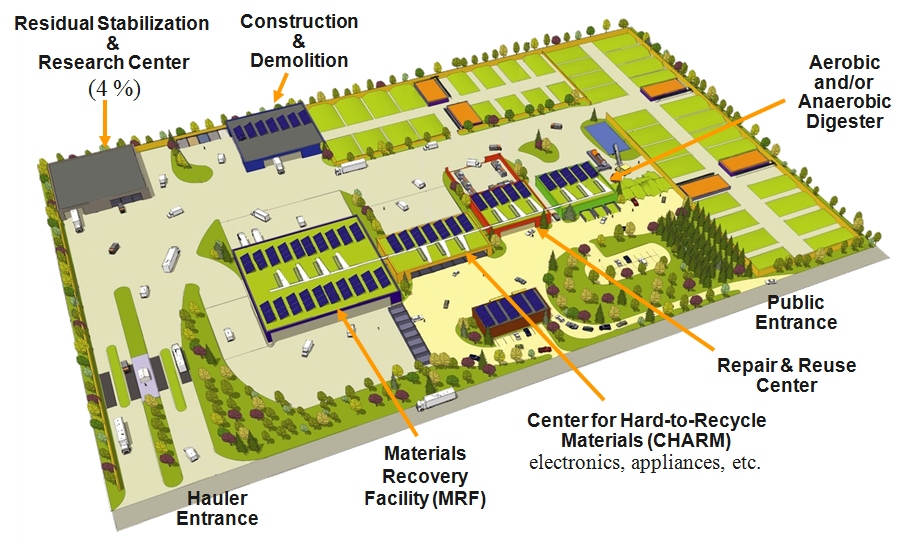July 25, 2016
by Chris Burger, Chair, AC Zero Waste Committee
Communities striving to be sustainable must address how they utilize material resources. This is not a responsibility that can be pushed off to someone else. As Wendell Berry says, Responsibility can be fulfilled or failed, but cannot be got rid of.
Traditionally, we've used resources in a linear fashion—extract, process, use>, dispose. The practice is unsustainable on so many levels and is especially disastrous on an environmental level. It is unjust for our current generation and for future generations. On the most fundamental level, in a finite world with finite resources, using resources in a linear fashion cannot continue forever.
This is why there's a slow shift from waste management to resource management, from How do we get rid of our waste efficiently with minimum damage to our health and the environment? to How do we handle our discarded resources so that we don't deprive future generations of their value?
In the past, the issue was safety. Now the issue is sustainability.
We must bend the arrow away from disposal and toward a system of either reusing, or reprocessing and reusing. While communities (both individuals and businesses) are justified in asking for assistance, responsibility lies at the point of purchase. This is where the turnaround must begin. After asking, "Do I really need the item?" (a question every business asks, but not asked nearly enough at the individual level)- we must then ask "Am I willing to take responsibility for it?" If not, leave it on the shelf.
Placing used and discarded material in the trash is not taking responsibility. As my friend Paul Connett would say, "Waste is the evidence that we are doing something WRONG. Incinerators BURN the evidence and landfills BURY the evidence." Neither is a magic box that makes waste disappear. Incinerators degrade resource utility (sometimes turning them into toxic compounds), while dissipating their byproducts into our atmosphere or into ash to be landfilled. Landfills basically warehouse the waste, creating a toxic soup called leachate, leaving that and other negative impacts for future generations to deal with.
 An infrastructure to facilitate the reuse, recycling, or composting of an item is crucial. Who pays for such a system is also important. There is a growing push to have producers pay for the recovery of the products that we purchase. Referred to as extended producer responsibility (EPR) or product stewardship, the program incentivizes reuse and recovery. Items harder to recycle will cost more while those items that can't be recycled or composted are discouraged. Efficiency will be rewarded, waste will be discouraged, and cost, previously externalized - will be reflected where it should be—in the price of the product.
An infrastructure to facilitate the reuse, recycling, or composting of an item is crucial. Who pays for such a system is also important. There is a growing push to have producers pay for the recovery of the products that we purchase. Referred to as extended producer responsibility (EPR) or product stewardship, the program incentivizes reuse and recovery. Items harder to recycle will cost more while those items that can't be recycled or composted are discouraged. Efficiency will be rewarded, waste will be discouraged, and cost, previously externalized - will be reflected where it should be—in the price of the product. How we utilize resources addresses our energy crisis as well. Thirty-eight percent of our energy is consumed to create the products we buy. This compares to 32% consumed to heat and cool our buildings and 18% for transportation (the other 12% goes to feeding us). While collecting and reprocessing these resources requires energy, a good two-thirds of the embedded energy can be saved with a lot less environmental impact than extracting and processing virgin material. The capital needed to achieve such savings is far less than the capital needed to achieve similar savings in the building or transportation sectors.
We should all be working to create resource management facilities within our communities. There is no single technology capable of addressing the total resource management task. Resource recovery parks are needed. Such parks employ a variety of technologies working collaboratively. They include a:
- material recovery facility (MRF) to handle distinct materials (glass, metal, paper, plastic)
- center for hard-to-recycle materials (CHARM) to handle items like electronics and composite materials (smaller operations would be simply bulk and ship - larger programs might include an actual disassembly operation)
- ReUse Store for reusable and refurbished items
- compost facility for organics
- construction and demolition processing operation
The Department of Environmental Conservation is proposing a major update to its waste facility regulations. Unfortunately, many of the regs are "old school" focusing on making waste disposal operations safe. If resource recovery parks were established, New York State has more than enough landfill and incinerator capacity to handle the residuals for the foreseeable future. Ideally, we could even start decommissioning existing ones. Sierra Club members should insist that communities switch their focus to resource management and take the zero waste pledge—while also taking the pledge as individuals. Many communities have already passed resolutions requesting the state to implement Expanded Producer Responsibility (EPR). Model resolutions for both can be found on our website (here and here). Members should also write comments to DEC calling for a halt to new landfill and incinerator construction while assisting in developing EPR-funded resource-recovery parks. Learn more about the DEC regs and making comments by clicking here. Be sure to check the Atlantic Chapter website in August for ways you can get involved in a comment drive.